Final Exam - Fundamentals of Speech & Hearing Science
1/39
There's no tags or description
Looks like no tags are added yet.
Name | Mastery | Learn | Test | Matching | Spaced |
|---|
No study sessions yet.
40 Terms
I Olfactory
sensory CN that supports smell; #1
II Optic
sensory CN that supports vision; #2
III Oculomotor
motor CN that supports eye movement; #3
IV Trochlear
motor CN that supports eye movement; #4
V Trigeminal
mixed CN that supports mandible & maxilla movement and sensation to the face, mouth, & jaw; #5
VI Abducens
motor CN that supports eye movement; #6
VII Facial
mixed CN that supports expression, gustation (taste), ear sensation, and movement to the lips & face; #7
VIII Vestibulocochlear
sensory CN that supports hearing and balance; #8
IX Glossopharyngeal
mixed CN that supports gustation (taste), ear sensation, swallowing, and movement to the superior pharynx; #9
X Vagus
mixed CN that supports pharyngeal, palatal, & laryngeal movement and sensation to the larynx, pharynx, and ear; #10
XI Accessory
motor CN that supports movement to the shoulder and neck and assists the Vagus; #11
XII Hypoglossal
motor CN that supports tongue and neck movement; #12
4
How many ventricles are there?
gustation
term meaning taste
ventricle
fluid filled cavities in the brain that contain cerebrospinal fluid to protect, cushion, and nourish the CNS
corpus callosum
the major commisural pathway that connects the left and right hemispheres of the brain
oligodendrocytes
glial cells in the CNS that produce myelin sheaths around axons
Schwann cells
glial cells in the PNS that produce myelin sheaths around axons
glial cells
neuronal cells in the nervous system that provide support and protection to neurons, maintain homeostasis, and produce myelin; act as the “dough” to the neurons
neurons
the basic functional units of the nervous system that transmit information throughout the body using electrical and chemical signals; responsible for receiving sensory input, sending motor commands, and relaying signals
brain and spinal cord
What are the parts of the CNS?
cranial nerves and spinal nerves
What are the parts of the PNS?
arcuate fasciculus
a white matter bundle in the brain that acts as a crucial pathway for language processing; connects Broca’s and Wernicke’s area
afferent
carry sensory signals from body to brain (from PNS to CNS)
efferent
carry motor signals from brain to body (from CNS to PNS)
brainstem
What is the origin of the cranial nerves?
thalamus
What is the pink structure labeled #1?
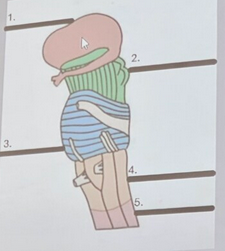
midbrain
What is the green structure labeled #2?
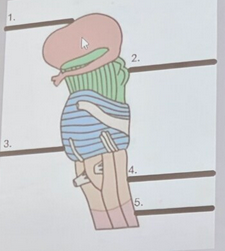
pons
What is the blue structure labeled #3?

medulla oblongata
What is the orange structure labeled #4?
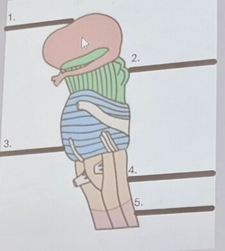
spinal cord
What is the red structure labeled #5?
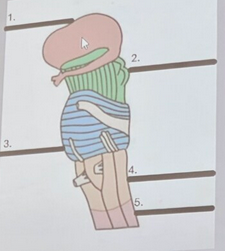
dura mater, arachnoid mater, pia mater
What are the 3 layers of the meninges from outermost to innermost?
False
(T/F) The lobes of the brain in either hemisphere are mirror images in structure and function.
medulla oblongata
Where do the nerves decussate to the opposite side of the body to maintain contralateral control?
frontal lobe
What is the blue structure labeled #1?
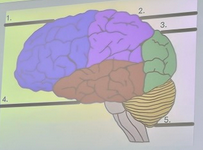
parietal lobe
What is the pink structure labeled #2?
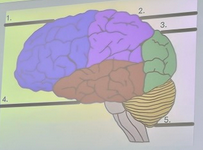
occipital lobe
What is the green structure labeled #3?

temporal lobe
What is the red structure labeled #4?

cerebellum
What is the yellow structure labeled #5?
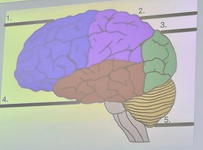
astrocyte
What is the most common type of glial cell?